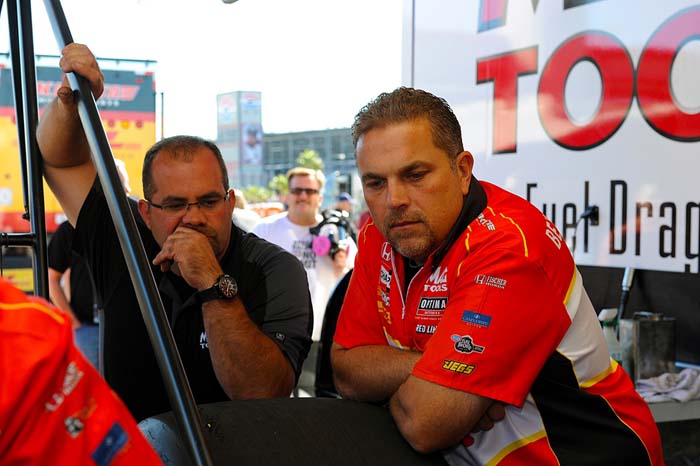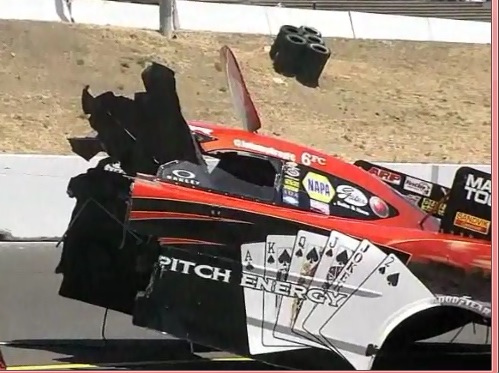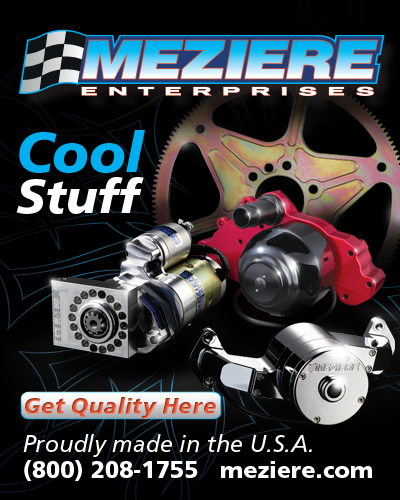KALITTA MOTORSPORTS TO TETHER CRITICS: OUR FANS ARE IMPORTANT, TOO

This is the belief which had both Kalitta Motorsports teams opt to keep their tether systems in place while the sanctioning body and its focus group studies a way to build a safer unit.
The body tethering issue reached a fevered pitch in the days leading up to this past weekend’s NHRA Northwest Nationals. During last week's NHRA Sonoma Nationals Johnny Gray’s Funny Car exploded the engine and split his Funny Car body in half. The NHRA said the tethering device worked as intended but an unforeseen result is what has inspired Gray to debate the issue. The explosion lifted the firewall which caused Gray's driving sight to be hampered. The damaged body also impeded Gray's exit from the car. The NHRA, responding to the driver safety concerns, made the unit optional when it was discovered the explosion pushed the saddle, which is the hooking unit on the back of the car, to move ten inches outside of its track.

This is the belief which had both Kalitta Motorsports teams opt to keep their tether systems in place while the sanctioning body and its focus group studies a way to build a safer unit.
The body tethering issue reached a fevered pitch in the days leading up to this past weekend’s NHRA Northwest Nationals. During last week's NHRA Sonoma Nationals Johnny Gray’s Funny Car exploded the engine and split his Funny Car body in half. The NHRA said the tethering device worked as intended but an unforeseen result is what has inspired Gray to debate the issue. The explosion lifted the firewall which caused Gray's driving sight to be hampered. The damaged body also impeded Gray's exit from the car. The NHRA, responding to the driver safety concerns, made the unit optional when it was discovered the explosion pushed the saddle, which is the hooking unit on the back of the car, to move ten inches outside of its track.
The NHRA and its tether focus group, later this week, will begin working on the development of a new saddle system to prevent instances like the one Gray faced from happening again.
Oberhofer says he isn’t looking to debate the vocal opponents of the tether units but does want one point known. He’s all for the safety of the race fans, the intended beneficiary of the unit.
“When I hear drivers say they don’t worry about the fans, I have a big problem with that,” said Oberhofer. “There were lots of times my wife and daughter sat in those grandstands. If we don’t care about the fans, that’s a problem.”
Oberhofer says many critics are losing sight of the intended use of the tethers while looking past other important questions.
“I think there are too many emotional decisions going on right now,” said Oberhofer. “People aren’t really thinking when there’s a bigger issue out there. Why did the car blow up? Why didn’t the safety system work? Why did [Bob] Tasca blow up, make a full run and didn’t have those same problems? We need to take a look at that stuff before we start throwing people under the bus.
“I worry about our fans. I don’t want to get someone hurt.” According to the NHRA’s Glen Gray, the reason the parachutes didn’t deploy was because an air-line [involving the parachutes] was damaged and it remains unknown at this time if the fuel shutoff worked as intended. The NHRA has requested data from DSR to determine if the fuel shutoff portion performed as it should have. Those results, according to Gray, will be analyzed once the tech department returns from the Seattle event.
According to the NHRA’s Glen Gray, the reason the parachutes didn’t deploy was because an air-line [involving the parachutes] was damaged and it remains unknown at this time if the fuel shutoff worked as intended. The NHRA has requested data from DSR to determine if the fuel shutoff portion performed as it should have. Those results, according to Gray, will be analyzed once the tech department returns from the Seattle event.
Oberhofer said both Kalitta Motorsports drivers wholeheartedly support the team’s stance in regards to keeping the tether systems on their cars. The decision was left up to Del Worsham and Alexis DeJoria.
“Our drivers made the decision to keep them, both Del and Alexis,” confirmed Oberhofer, who added team owner Connie Kalitta is a staunch supporter of the system if only to remove the chance for airborne Funny Car bodies.
This advocacy for spectator safety shouldn’t be construed as a lack of concern for driver safety. Oberhofer said he deals with the pain daily of losing team driver and friend Scott Kalitta, who was killed during a fiery crash in 2008.
Kalitta’s death was the impetus for the input of the Electrimotion device which automatically shuts off the fuel system and deploys the parachutes in the event of an engine failure. The device apparently malfunctioned during Gray’s engine explosion.
“Connie is adamant that we do what we can to protect our fans and our drivers,” Oberhofer emphatically stated. “So, don’t tell us about killing drivers; we have to walk down that road every day.”
The act of cutting and pasting articles from this publication to a message board is a clear copyright violation as is pulling photos to post on social media sites. All articles and photography published in CompetitionPlus.com are protected by United States of America and International copyright laws unless mentioned otherwise. The content on this website is intended for the private use of the reader and may not be published or reposted in any form without the prior written consent of CompetitionPlus.com.





































